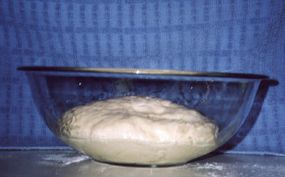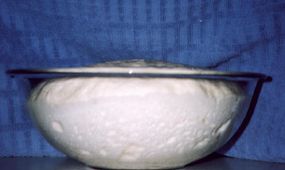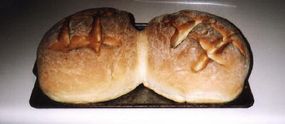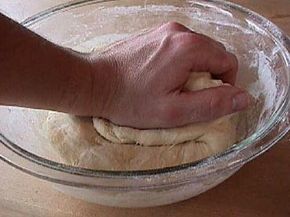Baking Sourdough Bread
You can find scads of sourdough bread recipes in cookbooks and on the Internet. You can find recipes for sourdough white bread, rye bread, whole wheat bread, biscuits and even cake. Once you have the starter, you can bake sourdough in countless ways.
The recipes use various terms related to starter, including sponge and poolish. Sponge often refers to the mixture of starter with the flour and other dry ingredients of the recipe added. Poolish is another name for sponge. Some recipes call for proofing the starter. To proof a starter, you take a portion of it out of the refrigerator and feed it for a day or so to get a foamy "proof" that the yeast are active.
Advertisement
Here's a simple sourdough recipe from a very popular cookbook that you might have on your kitchen shelf -- the "Better Homes and Gardens Cookbook," 1989 edition. This recipe cheats a little by using both sourdough starter and packaged yeast at the same time. In this case, the cup of starter provides the flavor and the packaged yeast guarantees that the bread will rise quickly and reliably.
Here is the recipe:
- 1 cup of sourdough starter
- 5 1/2 to 6 cups of all-purpose flour
- 1 package of active dry yeast (2 1/4 teaspoons)
- 1 1/2 cups of water
- 3 tablespoons of sugar
- 3 tablespoons of margarine or butter
- 1/2 teaspoon of baking soda
- 1/2 teaspoon of salt
You need to have the sourdough starter at room temperature, so if you have your starter in the refrigerator, put a cup of it out on the counter for a while before you start mixing the bread. You combine 2 1/2 cups of flour and the yeast in a big bowl (a 4-quart glass bowl will do). Heat the water, sugar, butter and salt until warm (110 degrees Fahrenheit or so). Add the liquid to the flour and yeast mixture. Then you pour in the sourdough starter. Mix with an electric mixer on low speed for 30 seconds. The mixture looks very smooth and creamy at this point, and smells very yeasty. Then you mix with the mixer on high speed for 3 minutes. This is when you begin to see the elasticity develop in the dough. It practically climbs up the beaters to the mixer! You need to keep a scraper or a spoon on hand to push the dough back down. It's fascinating to watch!
Combine 2 1/2 cups of flour with the soda in a separate bowl. Then add it to the yeast mixture. Stir this until the dry ingredients and the starter mixture are combined. Then try to add as much of the remaining flour -- 1/2 to 1 cup -- as you can. The dough gets pretty stiff at this point.
The next step is kneading -- a part of making bread that many bakers find most satisfying, because you can feel the dough changing in your hands as you knead. Put the dough on a floured surface and start pushing and pulling. It will take about six to eight minutes to get the dough to the right stiffness. You will know it is done when you can push on it with your finger and it pops right back instead of denting.
Shape the dough into a ball and put it into a greased bowl. Cover it and put it in a warm place to rise until it doubles in size -- about 45 to 60 minutes.


When it has doubled, punch it down -- another satisfying part of bread baking. Put the dough on a floured surface and divide into two parts. Cover these two lumps for about 10 minutes and let them rest. Make them into two round loaves. Put the two loaves on a greased baking sheet, and cover again to let them rise until they are about double in size (about 30 minutes). Then it's time to bake the loaves, in a 375-degree oven for about 30 to 35 minutes.

You should get a crusty bread with a hearty, chewy texture and that amazing sourdough taste!
You can find many recipes for starter and for sourdough bread in the Links section. You can even develop a starter that you can pass along to friends to start a new tradition!
Related HowStuffWorks Articles
- How Bread Works
- How Low-Fat Baking Works
- What is baking powder and how does it work?
- In a kitchen oven, what is the difference between the "bake" setting and the "broil" setting?
- How To Choose A Gas Grill
More Great Links
- Learn to make sourdough starter
- Sourdough and Sourdough Starters
- Sourdough Bread Primer
- How to Take Care of Sourdough Starter
- Fleischmann's Yeast site has a good bread beginner's guide
- How to Make San Francisco Sourdough Bread
- Sourdough recipes
- Sourdough links
- Starter recipe
- Starter recipe
- Yeast starter from Cooks' Encyclopedia
- Help for troubled starters
- Easy sourdough starter
- Amish sourdough bread starter
- Sourdough starter with honey
- Sourdough starter with potato
- Basic sourdough starter
- Sourdough chocolate cake
- Amish Friendship Bread
- Making sourdough starter breads in a bread making machine
- A bread making FAQ
- Sourdough definitions
